This article was published in Scientific American’s former blog network and reflects the views of the author, not necessarily those of Scientific American
There’s an unusual group of African rodents that we rarely get to hear much about. Termed dendromurines, they’re named for Dendromus, the climbing mice, and mostly inhabit sub-Saharan Africa. The fossil record shows that dendromurines have not always been exclusive to Africa, however, since fossils reveal their presence during the Miocene in Thailand and Pakistan. Virtually all living species can (perhaps arguably) be characterised as specialists and relicts that, so it’s said, have declined in importance and diversity over the last several million years (Kingdon 1997). This decline has been suggested to result from competition with murines – the group of mice that includes the more ‘modern’, familiar lineages.
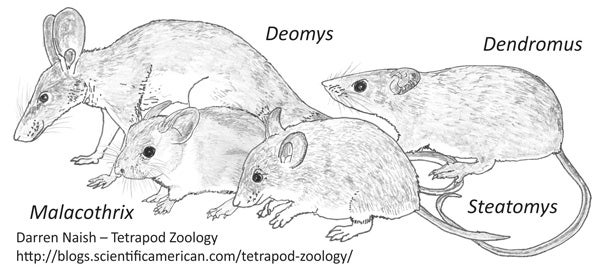
Dendromurine montage... but not all of these animals are really dendromurines. Read on.
Dendromurines were (like virtually all rodent groups regarded as ‘mice’) conventionally included within the family-level group Muridae. They’ve also been included within Cricetidae by some authors (ugh: someday I’ll have to explain the competing concepts of ‘Cricetidae’... what a mess) and have been regarded as worthy of their ‘family’ – Dendromuridae – by others. However, in recent years it’s been increasingly recognised that several African and Madagascan mouse lineages belong together in a clade that can be conveniently separated from Muridae and termed Nesomyidae. Cricetomyines (African pouched rats and kin: a group covered here back in November 2014) are nesomyids too.
On supporting science journalism
If you're enjoying this article, consider supporting our award-winning journalism by subscribing. By purchasing a subscription you are helping to ensure the future of impactful stories about the discoveries and ideas shaping our world today.
Complicating things further is that the several genera typically included within Dendromurinae do not form a clade. The group is actually paraphyletic or polyphyletic, its constituents classified together because they look approximately alike in some aspects of anatomy, including incisor, molar and jaw shape (Alston 1876, Verheyen et al. 1996). Nevertheless, a nesomyid clade that includes Dendromus and similar taxa does exist and can still be called Dendromurinae.
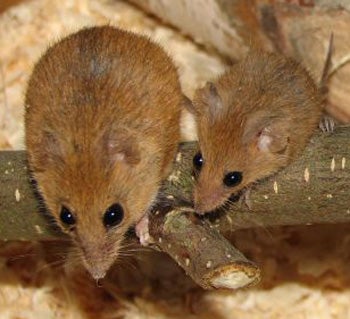
Captive mother and juvenile Dendromus mystacalis. Photo by Kenneth Worm, CC BY-SA 2.5.
The Dendromus climbing mice and kin. The most familiar animals within this group are the 11 or so Dendromus species. These are small, plain-looking, narrow-snouted mice that occur virtually , everywhere in Africa south of the Sahara (except for the south-west and the Horn of Africa) and can be found in savannahs, marshes, woodlands and other habitats. Data on their biology and ecology is mildly contradictory. A semi-prehensile tail, combined with hands that look suited for a climbing lifestyle (the first of the four manual digits* opposes the others and the hand has a so-called ‘padded hook’ appearance) makes Dendromus seem like a specialist climber. But apparently this isn’t so. Sure, it can climb well, but specimens tend to be encountered at ground level. Then again, we’re dealing here with a bunch of species that vary quite considerably in ecology, lifestyle and morphology – there are Dendromus species that are associated with dry, sandy habitats, with forests, with swampy lowlands, alpine habitats, and with other habitats too (Kingdon 1974, Nowak 1999).
* Or is it just three? I think it is but haven’t been able to confirm it.
And while they’re sometimes described as specialised eaters of grass seeds (Kingdon 1997) there are accounts of them eating insects, bird eggs, bird nestlings, lizards and even small snakes! I suppose they may well be mostly seed-eaters, the instances of snake-killing and so on being occasional outliers.
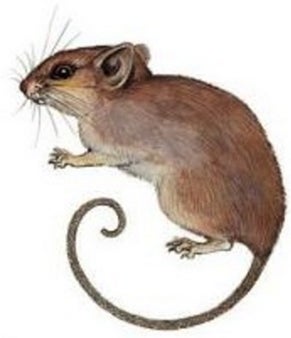
Jonathan Kingdon's illustration of Dollman's climbing mouse (from Kingdon 1997). There are hardly any available images of this animal - beware the images online that actually show a domestic house mouse...
‘Tree mice’ that might not be dendromurines. Typically thought of as close relatives of Dendromus are the Velvet climbing mouse Dendroprionomys rousseloti and Dollman’s climbing mouse or Dollman’s tree mouse Prionomys batesi, both of western equatorial Africa. Very little is known of either species. In fact, Prionomys went missing for about 50 years and was thought possibly extinct until its rediscovery in 1964. It’s predominantly insectivorous, mostly relying on ants, and it has several specialisations of the jaw joint and mandible that might relate to this way of life. New records of this species from the Republic of Congo were recently published by Denys et al. (2006).
Are these two really dendromurines? Denys et al. (1995) argued on the basis of tooth morphology that they’re not at all close to Dendromus, but are instead better grouped with spiny mice and murine mice. This remains the source of uncertainty and further information is needed – I don’t think either species has been included in any molecular phylogenetic work.
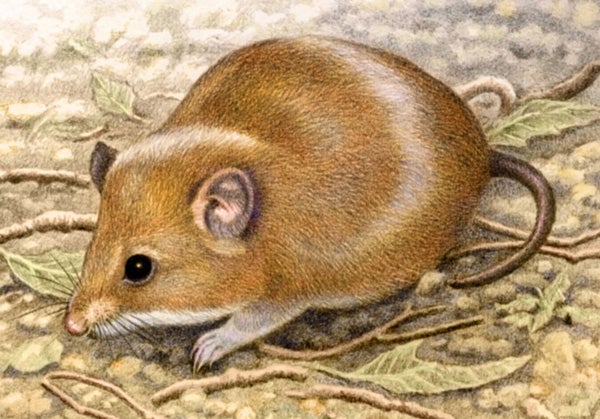
Excellent illustration of a fat mouse (Steatomys pratensis) by Willem van der Merwe, used with permission.
Fat mice and gerbil mice and kin. Rather different from Dendromus are the several stocky, short-snouted dendromurines with proportionally short tails. Examples include the possibly extinct Togo mouse Leimacomys buettneri, the fat mice (Steatomys) and the Large-eared mouse or Gerbil mouse Malacothrix typica. The Large-eared mouse is attractively marked, with a tawny brown face, white patches near its ears and on its throat and belly, and a light grey coat with darker grey streaks. Fat mice are (as you might guess) especially good at accumulating thick fat layers and they rely on these when aestivating during the dry season.
Molecular and morphological studies find Dendromus and Steatomys to be close relatives (Denys et al. 1995, Michaux et al. 2001, Jansa & Weksler 2004) and we can regard these rodents as the ‘core dendromurines’, or dendromurines proper, if you like. They appear to be especially close relatives of cricetomyines. Saccostomus – the vaguely hamster-like African pouched mice – might be closer to the core dendromurine clade than to cricetomyines (the group in which they’re conventionally classified) (Jansa & Weksler 2004, Nakamura et al. 2013). Dendromus and Steatomys are both known from the fossil record of the Miocene; Malacothrix first makes an appearance in the Upper Pliocene (McKenna & Bell 1997).
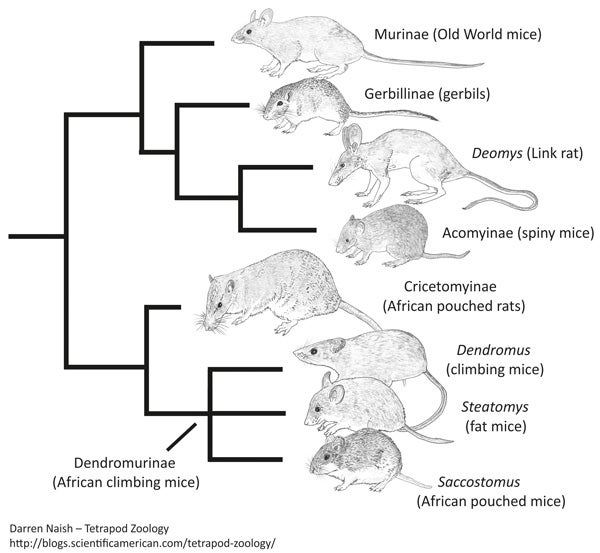
Simplified phylogenetic hypothesis for dendromurines and other muroids, based mostly on the molecular trees of Denys et al. (1995) and Jansa & Weksler (2004).
The Giant climbing mouse or Nicolaus’s mouse Megadendromus nicolausi (only discovered in 1978) is another probable ‘core dendromurine’, but it’s murine-like in two details of tooth anatomy. It also looks murine-like in having an especially long, slender tail. However, it’s otherwise essentially a ‘giant Dendromus’ (Denys et al. 1995). Megadendromus is endemic to high-altitude shrubland in Ethiopia and has digits suggestive of specialisation for a climbing lifestyle. Little else seems to be known about it, and it’s threatened by the use of its habitat for sheep grazing.
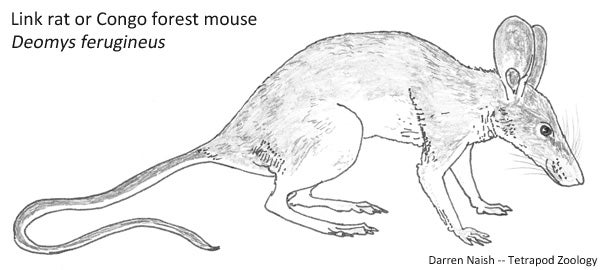
The Link rat. Perhaps the most interesting species typically included within Dendromurinae is the long-legged, big-eared Link rat or Congo forest mouse Deomys ferugineus. Its gigantic, narrow-based, high-placed ears stick up well above its long, flattish, pointy-nosed head, it has a markedly long, slender tail, and long, slim legs and feet. It fact it walks tall on its toes, its belly well up off the ground. In hindlimb length and gracility it groups together with a set of murids that have convergently evolved this stilt-legged morphology, perhaps representing adaptation to a life that involves wading and foraging at stream edges (Peterhans & Patterson 1995). It’s an equatorial specialist, inhabiting seasonally flooded forests of Cameroon, the Democratic Republic of Congo and adjacent countries, and is an omnivore that eats slugs, insects (especially termites) and millipedes as well as fruit. This diet is reflected in its dentition: its cheek teeth have tall, sharp cusps that are evidently suited for faunivory (Hanney 1975).
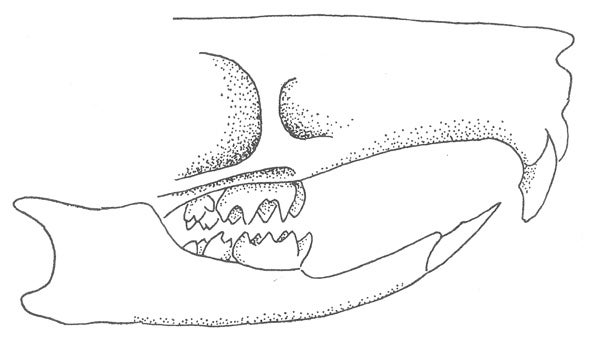
Diagrammatic skull of Deomys - check out those tall-cusped cheek teeth. Image from Hanney (1975).
Indeed, Deomys is really quite weird compared to the other rodent discussed here and consequently some authors have suggested that it should get its own ‘subfamily’, Deomyinae. Over the past few decades the idea that it might actually be a close relative of spiny mice (or acomyines) has become more popular (Verheyen et al. 1996, Michaux et al. 2001). Spiny mice are a mostly African group that includes the Acomys spiny mice as well as the brush-furred mice (Lophuromys). Acomyines were long regarded as being deeply nested within Muridae and among the closest relatives of Murinae, the ‘typical’ mice. However, it now seems that they (and thus link mice too) are not especially close to murines, but are instead either outside the clade that includes murines and gerbils (Dubois et al. 1999), or are close relatives of gerbils (Chevret et al. 1993, Michaux et al. 2001, Jansa & Weksler 2004).
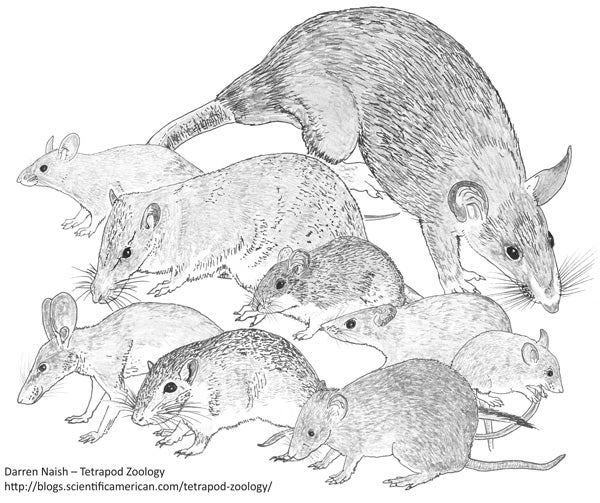
Montage depicting some of the muroids mentioned and discussed in this article. These illustrations - and many, many others - are being compiled for my big book project. You can help that project (and others) come to fruition by supporting me at patreon.
So there we have it – brief and cursory coverage of another rodent group. As always, there’s so much more to say, and so many other groups to cover. I aim to tackle more nesomyids... and maybe (dare I say it) some of the cricetines at some point in the near future. If you like rodents, remember that you can spread the word by wearing this outstanding t-shirt...
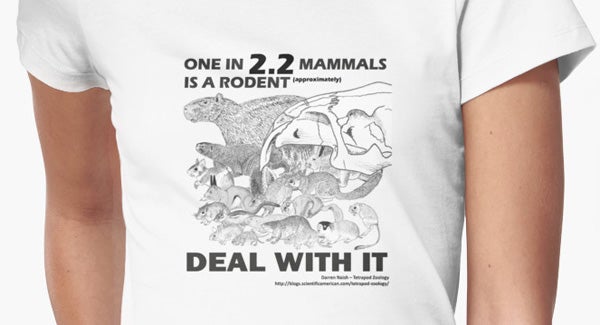
It's one of the best-selling Tet Zoo t-shirts. I'm serious. Buy it (and other merch) here.
And for previous Tet Zoo articles on rodents, see...
Refs - -
Alston, E. R. 1876. On the classification of the order Glires. Proceedings of the Zoological Society, London 1876, 61-98.
Chevret, P., Denys, C., Jaeger, J.-J., Michaux, J. & Catzeflis, F. M. 1993. Molecular evidence that the spiny mouse (Acomys) is more closely related to gerbils (Gerbillinae) than to the true mice (Murinae). Proceedings of the National Academy of Sciences USA 90, 3433-3436.
Denys, C., Colyn, M. & Nicolas, V. 2006. First record of the Dollman's tree mouse (Prionomys batesi; Mammalia: Nesomyidae) in the Republic of Congo and additional description of this rare Central African rodent. Zootaxa 1318, 59-68.
Denys, C., Michaux, J., Catzeflis, F., Ducrocq, S. & Chevret, P. 1995. Morphological and molecular data against the monophyly of Dendromurinae (Muridae: Rodentia). Bonner Zoologische Beiträge 45, 173-190.
Dubois, J. Y., Catzeflis, F. M. & Beintema, J. J. 1999. The phylogenetic position of "Acomyinae" (Rodentia, Mammalia) as sister group of a Murinae + Gerbillinae clade: evidence from the nuclear ribonuclease gene. Molecular Phylogenetics and Evolution 13, 181-192.
Hanney, P. W. 1975. Rodents: Their Lives and Habits. David & Charles, Newton Abbot, London, Vancouver.
Kingdon, J. 1974. East African Mammals. At Atlas of Evolution in Africa. II(B). Hares and Rodents. Academic Press, London.
Kingdon, J. 1997. The Kingdon Field Guide to African Mammals. Academic Press, San Diego.
Jansa, S. A. & Weksler, M. 2004. Phylogeny of muroid rodents: relationships within and among major lineages as determined by IRBP gene sequences. Molecular Phylogenetics and Evolution 31, 256-276.
McKenna, M. C. & Bell, S. K. 1997. Classification of Mammals: Above the Species Level. Columbia University Press, New York.
Michaux, J., Reyes, A. & Catzeflis, F. 2001. Evolutionary history of the most speciose mammals: molecular phylogeny of muroid rodents. Molecular Biology and Evolution 17, 280-293.
Nakamura, I., Hang’Ombe, B. M., Sawa, H., Kobayashi, S., Orba, Y., Ishi, A., Thomas, Y., Isozumi, R., Yoshimatsu, K., Mweene, A. S., Takada, A., Sugimoto, C. & Arikawa, J. 2013. Cross-reactivity of secondary antibodies against African rodents and application for sero-surveillance. Journal of Veterinary Medical Science 75, 819-825.
Nowak, R. M. 1999. Walker’s Mammals of the World, Volume II (Sixth Edition). The John Hopkins University Press, Baltimore and London.
Peterhans, J. C. K. & Patterson, B. D. 1995. The Ethiopian water mouse Nilopegamys Osgood, with comments on semi-aquatic adaptations in African Muridae. Zoological Journal of the Linnean Society 113, 329-349.
Verheyen, E., Colyn, M. & Verheyen, W. 1996. A mitochondrial cytochrome b phylogeny confirms the paraphyly of the Dendromurinae Alston, 1896 (Muridae, Rodentia). Mammalia 60, 780-785.